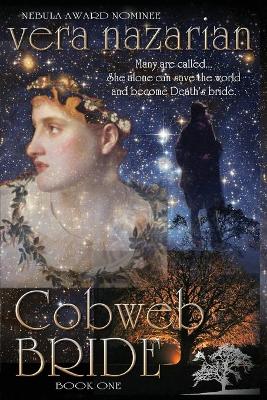
Berls
Written on Jul 30, 2013
My Initial Reaction…
For me this book has two parts: the first half, which is very slow moving, overly descriptive, and yet so promising; and the second half, which is page-turning, perfectly paced, and exciting. This is a book you have to stick with to get to the good parts, but if you do, you will be rewarded.
The Characters…
Amongst the many characters in Cobweb Bride, for me, two women carried the story: Persephone (Percy) Ayren, and the Infanta Claere Liguon.
Percy is the star of this story and I absolutely fell in love with her. As the less-attractive and unwanted middle child, Percy has gotten used to being ignored and unappreciated by all in the family, except sometimes her father. But when she sets out for death’s keep in the north, to possibly become his Cobweb Bride, she grows into a strong, confidant young woman and it is beautiful to watch. Percy stops hiding in the shadows and starts being an assertive leader, even as she struggles to understand herself and her place in this mess.
The Infanta is a fascinating character. We meet her on her birthday, a sickly heir to the throne, barely able to handle being in public for a few hours. That all changes with her death; because she cannot move on, death for Claere is a release from a life of pain and weakness. Suddenly she finds her purpose – to be the Cobweb Bride – and she is resolved to make it to Death’s keep, dead or not. In fact, one of the things I enjoyed most about this book was the way dead characters grew and changed in response to their death.
The two principal male characters of the story, the black night Beltain and the marquis Vlau Fiomarre, each had difficult moral dilemmas to deal with that forced them to question who they were and who they served. Within the opening pages, Beltain’s father is killed in battle but, since he does not actually die, Beltain must decide to whom he owes his allegiance: his father, who is rapidly changing after his death, or the Emperor and his own conscience? Vlau’s loyalties are also tested, for before the start of the novel he is told of his father’s and brother’s deaths at the Silver Court by the Emperor’s order; should he avenge their deaths or follow the Infanta, heir to the Empire?
This story is one of those with several different plots taking place simultaneously but all interrelated in some way. Some of those interrelations we see fulfilled in this book, others I suspect will be important in the other two books of the trilogy. The characters were really well written, some more than seemed necessary for this book (e.g., the Prince and Princess Osenni of Lethe) and I can only suspect that they also will become important characters in later books. I particularly enjoyed the way Nazarain wrote each of the girls traveling together so individually; they each of have distinct personalities and you grow to care for (or be annoyed by) each and every one of them.
The Story…
Cobweb Bride takes place in an alternative Renaissance world where all death has suddenly stopped. The opening chapter travels between different sites throughout the kingdoms, showing the devastating consequences of death’s stopping. Death himself appears to the Prince and declares that until he has his Cobweb Bride, death will be suspended. The scenes are extremely descriptive and devastating; by the end of the first chapter you fully appreciate why death must resume. Unfortunately these scenes are so descriptive that they can drag on too long. After a couple stops, you’ve gotten the picture and are really ready for the story to move on, but it doesn’t. I understand that Nazarian is usin these stops to introduce readers to the primary characters of the story, but for me it was labored and hard to get through.
Things begin to pick up after the Emperor’s order goes out, sending young women from all the land to the north to search for Death’s keep and to offer themselves as potential Cobweb Brides. Unfortunately, this doesn’t really get going until we’re halfway through the book. Thankfully, it goes from slow-moving to exciting. The second half of the book, as we follow the journeys of the Infanta on one path and Percy, along with several other girls, on another drew me in and I could hardly put it down. Paths start to intersect in sometimes predictable, but often unexpected ways.
I was a little disappointed by Percy’s interaction with Death. In an effort to avoid spoilers, I will just say that it was a bit stilted and, as a result, some of the following events felt off for me. That aside, I really enjoyed the way the Nazarian has reworked the Persephone myth and managed to weave several surprises into predictable myth-based developments to the story. Her attentiveness to detail made the cessation of death poignant and, when it didn’t slow down the pace, made the story come to life.
Concluding Sentiments…
If you came to this story for the Romance, you will be disappointed as it’s barely an undercurrent for most of the story and was pretty awkward when it was present. But I would definitely recommend this story for fantasy readers and, if the descriptions of death won’t disturb you, I think readers of young adult literature would probably really enjoy it as well.
I have to add that this book ended with one of the best concluding lines I’ve read in a story and I look forward to the next book.
